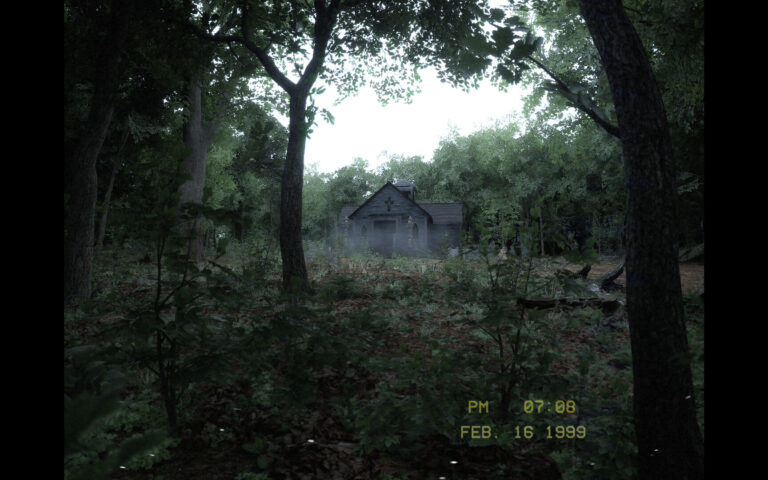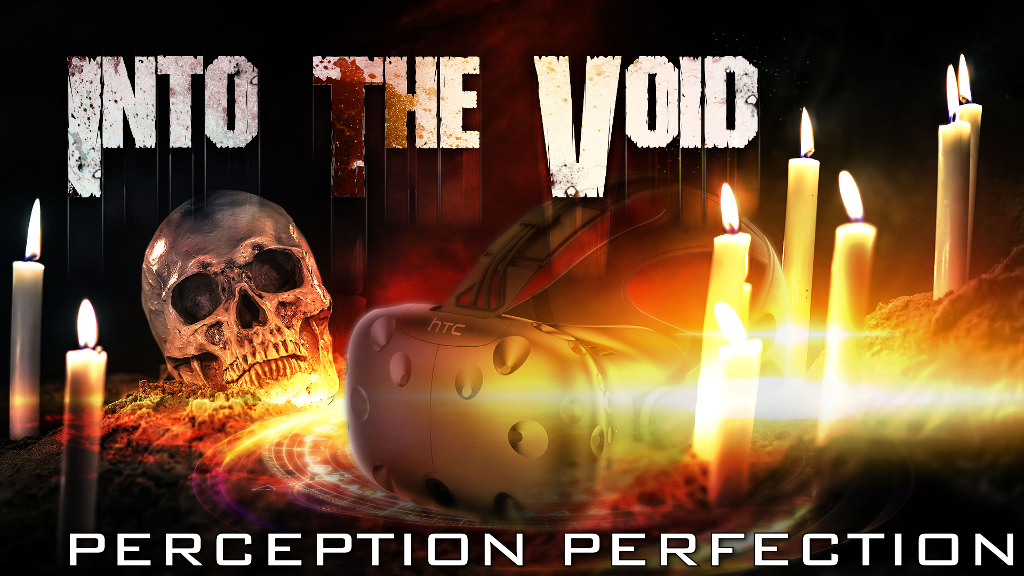
Here we are once again. I’ve resurfaced from a realm of falsehoods and simulations, ready to talk about the latest virtual reality experiences I’ve had within the horror genre. This is Into The Void — an article series that examines VR horror games, their design, and the unique psychophysical effects they produce.
The Forest
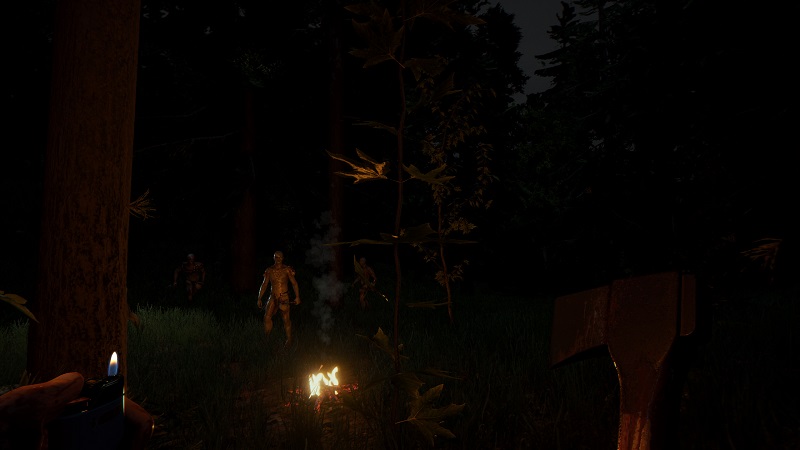
Endnight Games’ woodland survival game received VR support shortly after its exit from Steam Early Access last April, and I didn’t expect much from it, to be honest. But after spending a bit of time with it in VR, I came away fairly impressed. The Forest can be a tranquil experience given the game’s environments of dense forests, streams, and mountains, but its scenic sights and sounds are undermined by gameplay that fosters paranoia. If you weren’t aware, you’re not alone in this forest.
Amidst the daily activities to maintain your camp and resources, to survive The Forest is to contend with the area’s cannibalistic natives. These figures may appear at any time, and based on how you’ve dealt with them last, they’ll react with animalistic hostility or survey from afar. It’s this unpredictable nature that makes playing The Forest so anxiety-inducing. These figures (at first) look like tribalistic human beings and aren’t exactly imposing. But their AI is cunning and predatory — and you are the prey. Simply chopping away at a tree knowing these ghouls are out there made me more alert and prone to looking around in between swings. Having my back turned toward the endless number of hiding places a forest provides created a sense of (or maybe a desperate need for) spatial awareness. My ears felt tuned to the sounds of my surroundings, listening and processing the location of each source and its approximate distance. If anything broke the ballad produced by the trees, wind, or wildlife, I had to react.
While The Forest also supports online co-op, if you’re looking to fully appreciate the game’s unsettling vibe, go at it alone. Though, if you want to play patty-cake in a forest with a best bud and kill monster-people, that’s an option too!
The Exorcist: Legion VR
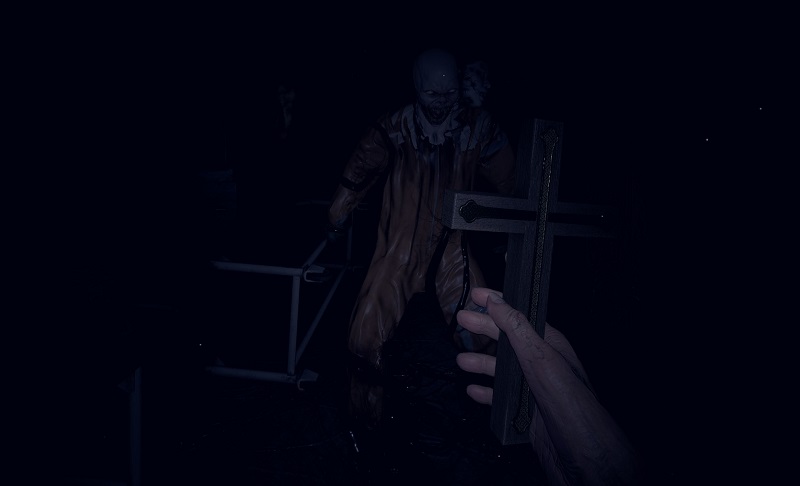
In my first entry of this article series, I wrote about how Legion VR was so far the scariest game experience I’ve had in some time. After completing the game’s five episodes, I have some additional thoughts about the medium and horror game design. The question “would this be as scary in 2D?” comes to mind when I think about a game like Legion VR, which heavily relies on set pieces and scripted scares.
Does the intimacy of VR automatically make horror design “easier” to pull off? Legion VR cannot be played in 2D, nor could I magically re-experience segments that I’ve already played, so I need to re-evaluate its methods. The game’s five episodes span various locations and make use of expertly framed scares to stir players. There are multiple scenes where entities position themselves in front of you, or it’s implied that they’re suddenly behind you. This perceived invasion of personal space is truly effective. And because the game establishes that it can and will make use of this to scare you, there’s a lingering threat of it happening again. But it’s this feeling that makes Legion VR a frightening experience in VR and only in VR (to me).
Jump scares, at least in 2D, don’t scare me; they startle me. A quick cut, a loud sound — the body naturally reacts in surprise. I personally don’t seek out that type of horror when I’m in the mood to be unsettled by spooky things because the emotional response feels manipulative and artificial. There’s no sense of dread. In VR, though, the increased sense of immersion enhances jump scares, because on some level there’s a sense of intrusion. Does that mean VR horror is “easier” to design or are existing — and sometimes vapid — methods are simply more effective? What may be relatively mundane and uninspired becomes elevated to due to the medium in which it is experienced.
Perhaps it’s best to think about VR horror game design not having a lower bar but instead its own scale. By nature, the medium is more immersive and “real” to the player. Horror game developers will do their best to utilize what’s available to them, and that makes some types of less appealing design choices fair game again. I’ll still stand by this, though: in moderation, jump scares can compliment a horror game well. Conversely, developers that rely primarily on jump scares lack imagination and style. Substance is required elsewhere — the story, the art, the ambiance, and the music. Legion VR does tick some of those other boxes, thankfully.
All of that said, Legion VR accomplishes what it sets out to do: scare you. It avoids feeling cheap by making use of excellent visual and sound design and imaginative scenarios. All of its scares will likely lose their effectiveness once you’ve completed the game once, so consider a purchase the price of admission to one solid haunted house ride.
Stifled
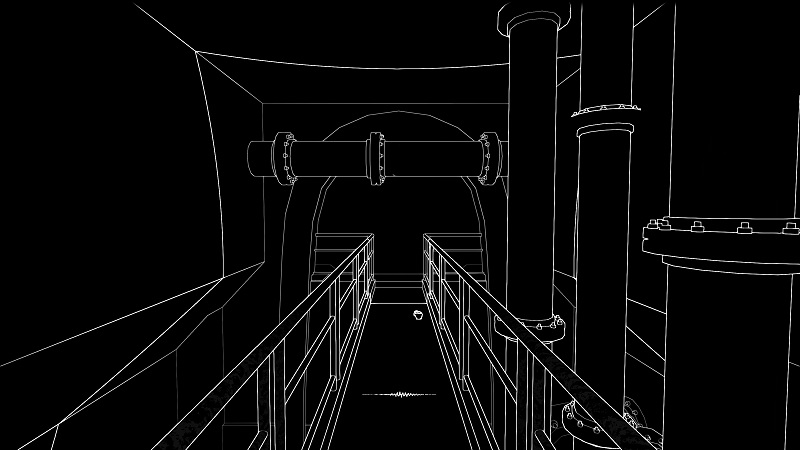
So far, most of my VR experiences have been set in games with traditional visuals — 3D objects and settings that appear as we see everything else in our day to day lives. Stifled is a game that changes how we perceive the world by shrouding everything into complete darkness. The world is only visible when sound is created, which in turn outlines everything in simple white lines. No light sources are present.
On paper, this sounds like it would be difficult for the mind to comprehend in VR. But somehow it works. VR headsets are, of course, creating a 3D image by projecting images to each eye. We perceive depth based on perspective, relative size, occlusion, and a multitude of other indicators — some learned. This analysis is more about my interest in how the game’s visuals translate to VR than how it aids the horror, but I wanted to make that observation. In terms of scares, I’ve played just a small bit of Stifled so far, and it was the same section I played and wrote about some years ago for a preview. I’ll need to revisit this one in the future as my backlog diminishes.
Hellblade: Senua’s Sacrifice
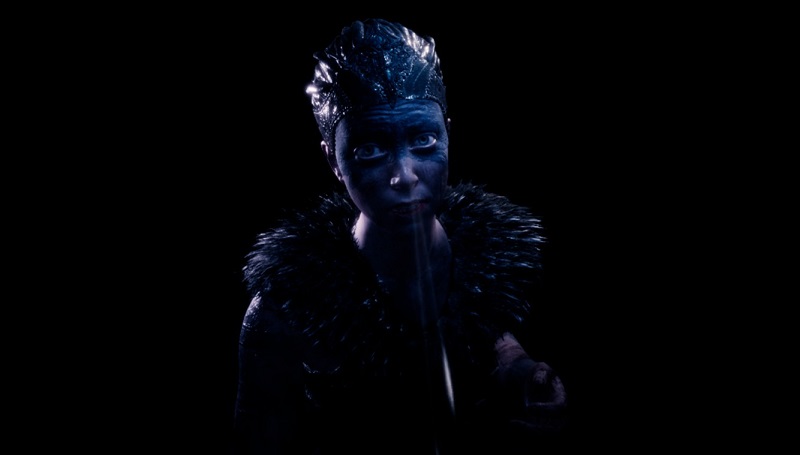
Developer Ninja Theory created a marvelous game with Hellblade, and their ongoing support of the game’s fanbase and mental health organizations continues to impress. This support extended to a free VR version of the game for existing owners after Ninja Theory had fun tinkering with VR internally. Hellblade was my first experience with a third-person VR game, which brings about some thoughts on immersion and VR storytelling.
If you’re not familiar, Hellblade follows the journey of Senua through Helheim (Hell in Norse mythology). Senua’s greatest foe lies within herself, as she struggles with psychosis. This manifests in the game as her hearing voices and enduring hallucinations. Senua often looks directly at the player, who effectively haunt her as one of her onlookers. This context justifies the game’s third-person VR support, allowing the player to imagine themselves as one of Senua’s manifestations — to follow her plight and watch her endure soul-wrenching realizations.
Hellblade is an emotional experience rivaled by very few other games. Playing it in VR places the player alongside Senua, whereas other games improve immersion by letting players embody a character. Watching her weep and scream in front of me made empathizing even more so. In some scenes, she maintains eye contact by tracking the position of the headset; the first time this happened I felt guilty and uncomfortable. It’s a great effect, though!
Regardless of perspective, Hellblade’s narrative posits the player as Senua’s (unwanted) guest. The move to third-person VR is fitting and surprisingly effective. I felt a little bit of nausea playing for an extended amount of time, but it wasn’t too severe. This is a great way to replay the game if you have the option.
Bring to Light
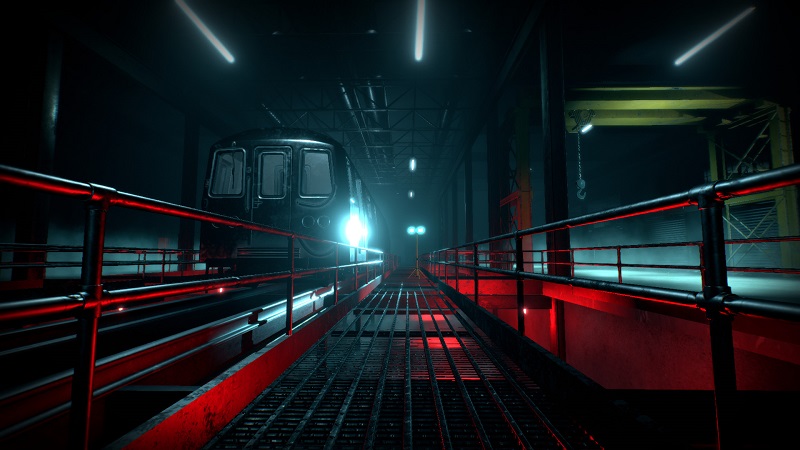
Want to know how to make a VR game less immersive than a 2D game? Significantly limit the player’s movement in a poor attempt to achieve tension. Out of the gate, Bring to Light seemed dedicated to being unintuitive. The fact that control over the game would cease to function unless restarted if the Steam overlay was opened was just the start.
Bring to Light has a decent premise: explore a subway system built over a hidden, Lovecraftian temple filled with horrors. The game’s visuals are pretty good, and the added (though limited) support for a heart rate monitor is a neat feature. Playing the game was an absolute slog, though. Its method of movement is a teleport system rather than free locomotion (click to move to a highlighted spot versus standard thumb control). This is fine; I’m used to both forms and some games do one style better than the other. In the case of Bring to Light’s teleportation control, it’s a source of frustration.
Movement is limited to just several feet ahead of the player, making walking a repetitive and uncomfortable task of pointing and clicking pointing and clicking pointing and clicking pointing and clicking. Fatigue set in quickly. It’s as if the movement was limited for the sake of retaining a pace that complimented the game’s scripted scares better. It didn’t, because I felt the least immersed in a VR game than ever before. Combine frustrating controls and very repetitive level design to get lost in, and boy do you have an angry CJ.
That said, I haven’t played the game since release in July. There’s no indication that the game’s movement control received any updates. Developer Red Meat Games replied to a Steam forum post in July about them considering locomotion support, but they have not said anything since on the matter. Shame, because the biggest thing here preventing me from experiencing all Bring to Light has to offer is what I’d typically expect to be improved in VR — the controls. And to be fair, it’s playable in 2D with standard controls, which is how I’ll have to go about playing the next time I launch it.
VR Accessory Review: VROptician Prescribed Lenses
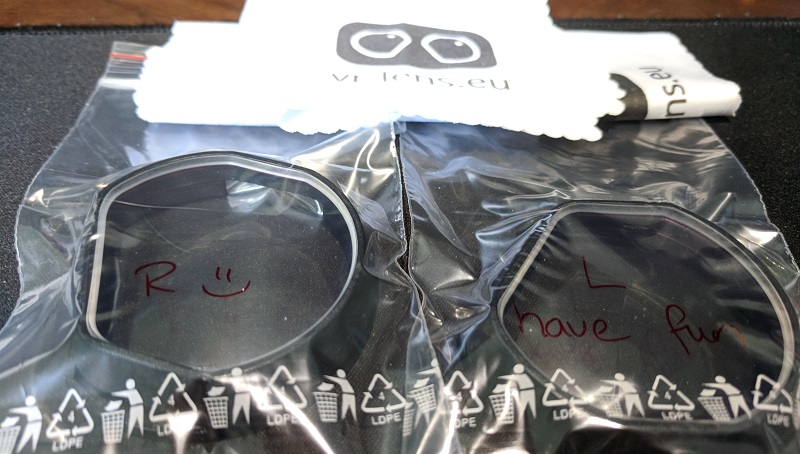
If you’re a glasses wearer, like me, the ritual to begin playing a VR game can be all the more irritating. Despite having a sizeable playspace in my living room close to where my desktop is, I need do the following before I start playing any VR game: move a table, power both lighthouses, place the piece of cardboard I cut to size into the frame of the living room mirror to avoid tracking issues, move my dog to the couch, pull out the Vive, plug it in, position the cord, and start SteamVR. Once it’s time to put the Vive on, careful placement in consideration to my glasses is needed. This extends to taking off the Vive as well. Glasses will scratch the lenses of your precious, expensive headset — which is what happened to me. Trying to escape reality can be quite a pain in the butt.
I had enough. First, I purchased some Polywatch polish to restore the Vive lenses myself to avoid exorbitant repair fees and wait times (repair guide here). I then researched my options for prescribed lenses. Thanks to positive reviews on Reddit, I came across VROptician (previously known as VR-Lens Germany). Their flat rather than curved lens inserts came highly recommended over other brands. I reached out to the company for more info, and they were nice enough to send me a review sample. Since the lenses arrived, VR has never been better.
VROptician is a two-man team who operate the company alongside their full-time jobs. They offer prescribed (and un-prescribed) Carl ZEISS Vision lenses for most leading VR headsets starting at €69. ZEISS BlueProtect lenses are available for an extra €30 — cost wise, you’re essentially buying a pair of decent glasses.
Though shipped from Germany, my lenses arrived sooner than the month-long ETA I was given. Popping them in was relatively easy, but if you’re like me and get nervous around expensive electronics, you may be worried about applying too much pressure to snap the inserts into place. The difference in comfort, FOV, and clarity was immediately noticeable. No longer did I need to fiddle with my glasses throughout play or worry about them touching the Vive’s own lenses. And because I play a lot of Beat Saber as a form of fun cardio, I don’t need to worry about lens fog as often either — just my luscious eyelashes leaving smudges from time to time. The packaging included microfiber cloths for each insert, though the quality of cloth can be improved as a few rogue fibers were noticeably coming off of them.
If you’re an avid VR fan with poor eyesight, prescribed inserts are a must. WIDMOvr offers a nearly identical product to VROptician for roughly the same price, with complimentary attachable covers, but it appears their inserts have smaller lenses and thicker plastic molding. My biggest complaint would be the lack of left or right indicators on VROptician’s offerings. Otherwise, they make a solid product that elegantly solved one of my frustrations playing VR games. Now to resolve that annoying headset wire…
–
I’ve still got quite the VR backlog to go through, so stay tuned for more Into The Void in the future! If you’d like to feed my VR addiction, you won’t have much trouble finding my Amazon wishlist… Also, be sure to read my full Transference review here.


